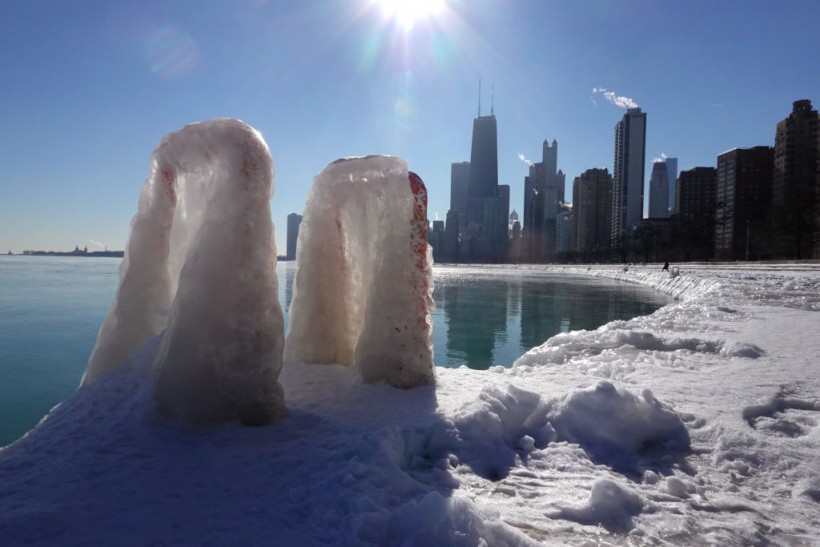Freshwater ice melts into different shapes depending on the water temperature-a discovery made by researchers in a new study.
The researchers claim, unlike ordinary water, freshwater reacts differently at a molecular level when faced with varying water temperatures.
The mechanisms within freshwater allow it to melt into three different shapes such as downward-facing spikes, scallops, and upward-facing pinnacles.
Conventional knowledge indicates water follows the shape of its container and transforms from one state into another. The recent discovery shows that frozen water can also make its own shape.
A Breakthrough Discovery

Researchers published a new study in the journal Physical Review Letters on January 28. The new study highlights the shape dynamics of ice suspended in cold freshwater.
The study involved experiments that reveal freshwater ice reacts differently to varying water temperatures when being melted.
When melted under a certain water temperature, freshwater ice transforms into three different shapes such as downward-facing spikes, scallops, and upward-facing pinnacles.
The new study concluded that ambient temperature affects the molecular-level behavior of freshwater ice. The molecular behavior changes the melted ice's density as a response to its surroundings.
Also read: Ice Pancakes: Rare Disk-Shaped Ice Formed in Lake Michigan, Creating Spectacular Views
Experiments Used for Melting Freshwater Ice
Before getting to the conclusion, the study's researchers conducted experiments on freshwater ice in a controlled environment-with only variances in water temperature.
First, freshwater ice turned into sharp downward-facing spikes when the researchers subjected it to lower water temperatures, approximately below 5 degrees Celsius.
Second, the researchers attempted to melt the freshwater ice with water temperatures between 5 and 7 degrees Celsius. As a result, the ice transformed into a scalloped waves-like shape.
Lastly, the researchers had seen upward-pointing pinnacles when they increased the ambient temperature of the melting freshwater ice.
Shape Dynamics of Freshwater Ice
Water, consisting of hydrogen and oxygen, covers approximately 70% of Earth's surface. Water naturally reacts depending on the temperature and it can be in the state of solid, liquid, or gas.
The changing of water from one state into another is also based on its melting point and freezing point which is reached based on the current temperature, according to the Lunar and Planetary Institute.
In the study's experiments, the researchers discovered that freshwater ice is following shape dynamics that have not been discovered yet and is contrary to what we know about water.
In the study, freshwater ice follows the shape dynamics-which indicate that freshwater is at its densest at 4 degrees Celsius. The density becomes less dense and rises which leads to the formation of downward-facing spikes, according to the new study.
Furthermore, the shape dynamics of freshwater ice dictates that when it is placed in water temperature between 5 and 7 degrees Celsius, the water becomes confused. The ice then forms different scallop-like layers, according to Leif Ristroph, a mathematician at New York University, cited by Science News.
Lastly, the ice melted into an upward-pointing spike when the researchers melted it with a water temperature above 7 degrees Celsius.
The shape dynamics reportedly show that the colder water near the ice is denser than its surrounding waters.
The colder water near the ice pulls the warm water above the freshwater ice and causes it to melt faster than the bottom part of the ice.
Related article: Mysterious Ice Disc Appears in Michigan River
© 2024 NatureWorldNews.com All rights reserved. Do not reproduce without permission.

![Climate Change is Reducing Dust Levels Worldwide as Arctic Temperature Warms [Study]](https://1471793142.rsc.cdn77.org/data/thumbs/full/70320/280/157/50/40/climate-change-is-reducing-dust-levels-worldwide-as-arctic-temperature-warms-study.jpg)

![Tsunami Hazard Zones: New US Map Shows Places at Risk of Flooding and Tsunamis Amid Rising Sea Levels [NOAA]](https://1471793142.rsc.cdn77.org/data/thumbs/full/70325/280/157/50/40/tsunami-hazard-zones-new-us-map-shows-places-at-risk-of-flooding-and-tsunamis-amid-rising-sea-levels-noaa.jpg)

